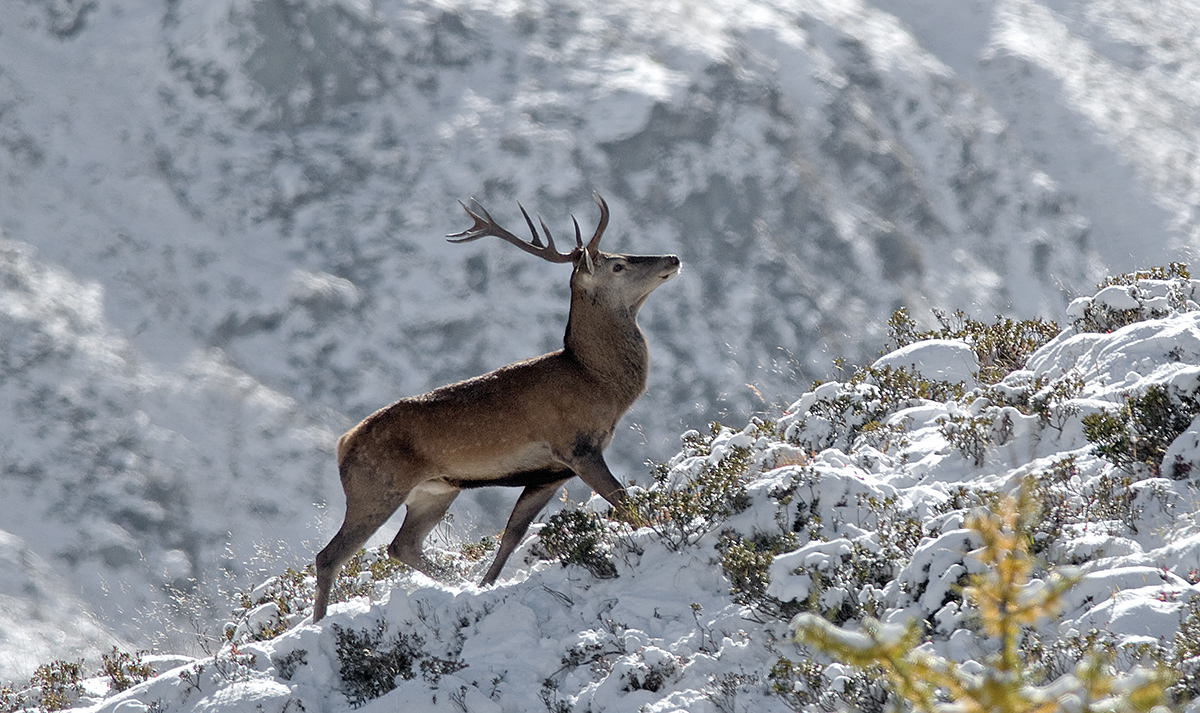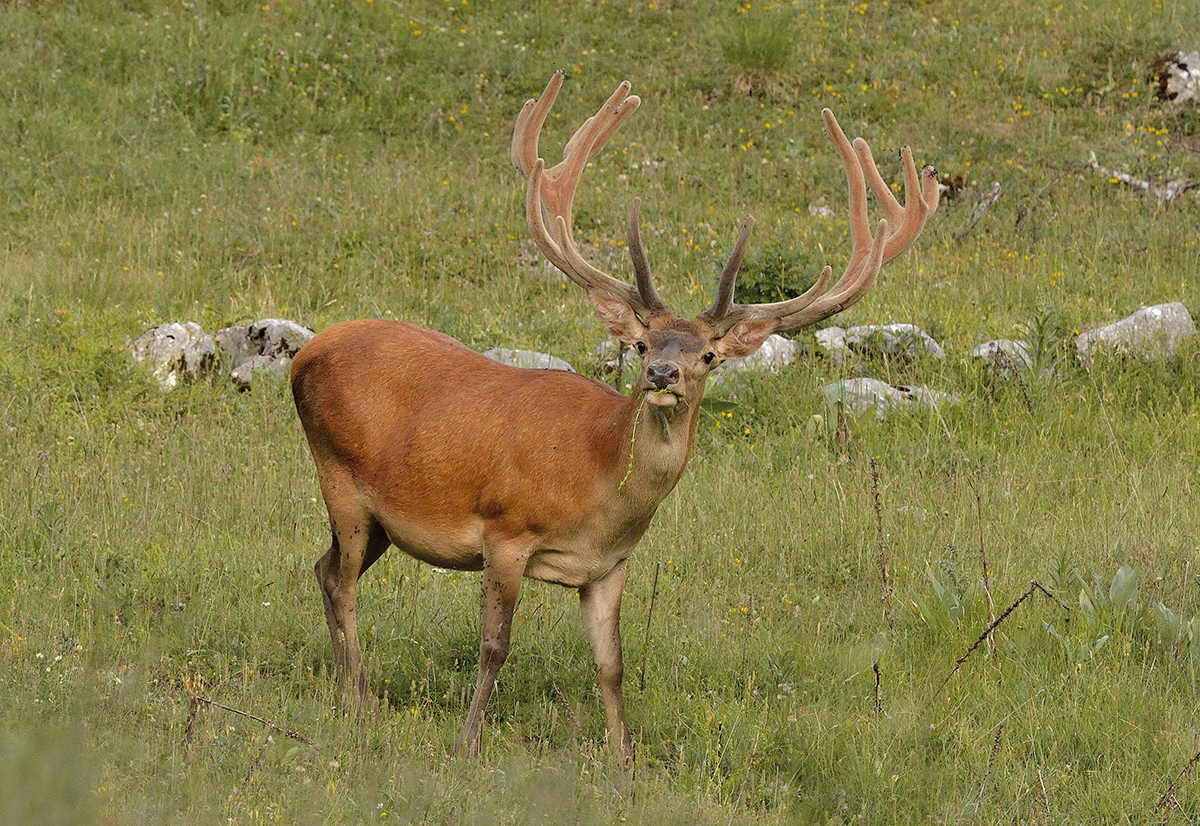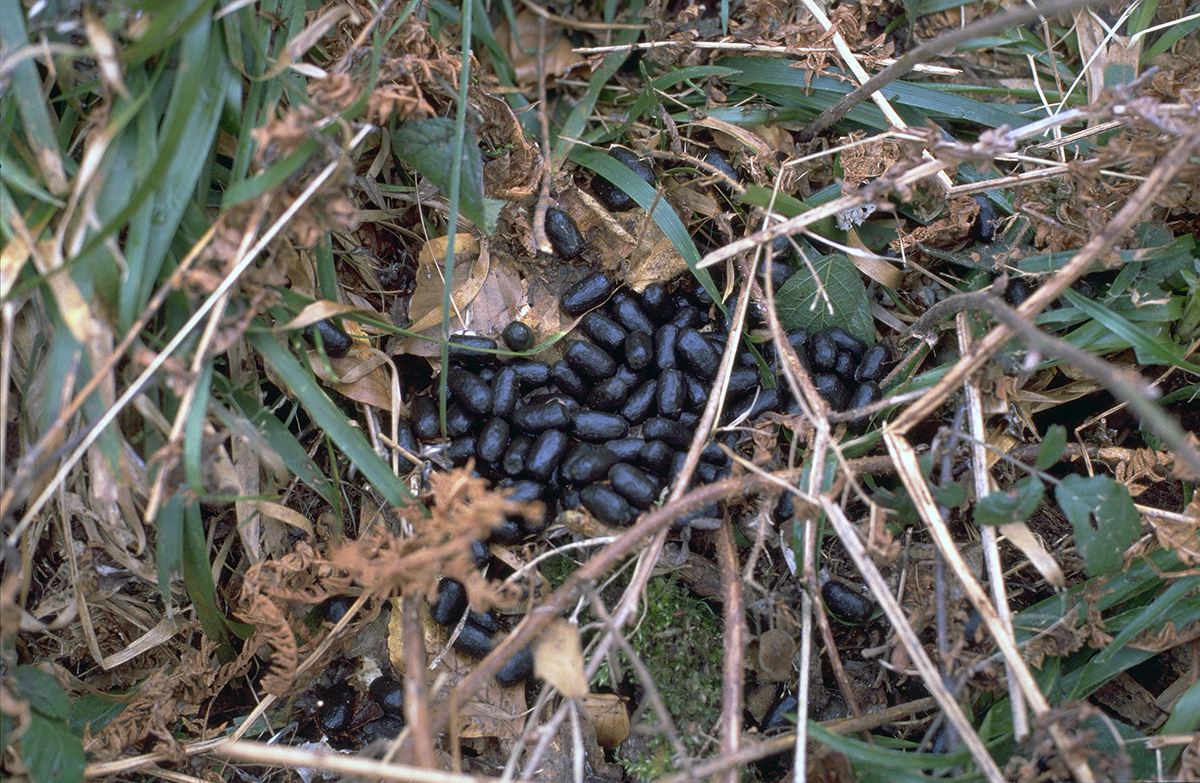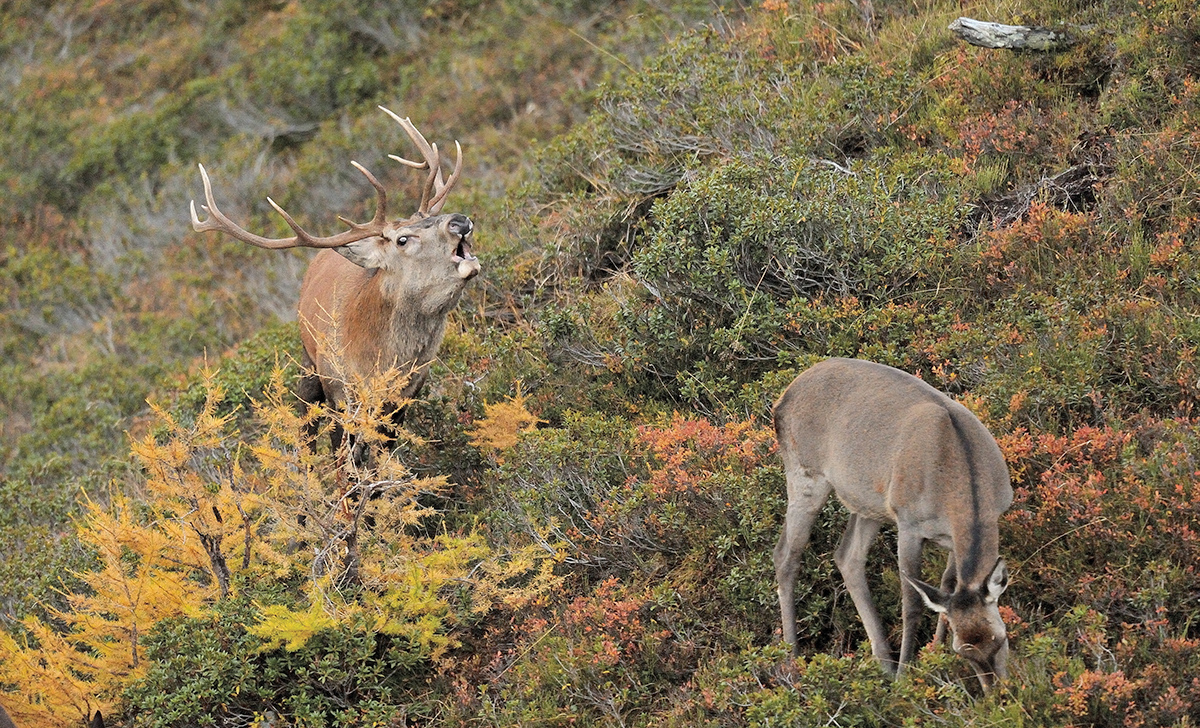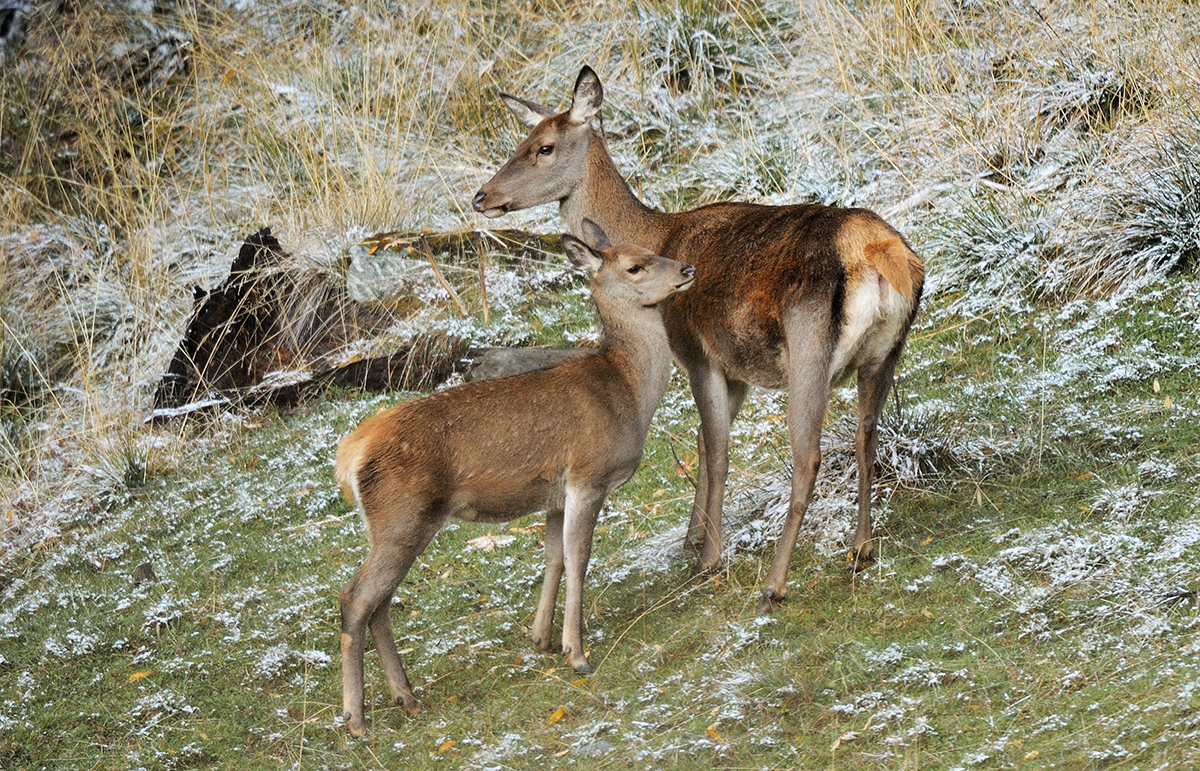Since the disappearance of the brown bear from the forests of Central Europe, the red deer has become the largest wild mammal here. This impressive, powerful animal displays a spectacular head of antlers and adapts well to high-altitude conditions. Although it was almost extinct in Switzerland around 1850, it now inhabits a large part of the mountain forests again.
Apperance
A fully grown male red deer (stag or hart) stands 120-150 cm high at the shoulder and weighs between 170 and 220 kilos. It is thus around eight times heavier than a roe deer. The red deer hind is considerably smaller, standing 100-120 cm tall and weighing 90 to 130 kilos. Once it has lost its antlers, the stag can be recognised by its massive, stocky body, powerful chest and strong neck.
The red deer belongs to the order of even-toed ungulates (suborder ruminants) and cervid family, and has a horizontal spine. The male animals bear large antlers. They change coats twice a year, with the short, reddish coat they have in summer being replaced by thicker hair and turning greyish-brown in autumn. They have yellowish thighs, tails that grow to a length of around 20 cm, and a dark stripe along their spines.
During the rut, stags have long, thick neck manes. Both sexes have preorbital glands at the inner corners of their eyes, in the so-called tear duct. They mark their territory with the secretions from these glands. The deer have further scent glands on the outside of the hind legs and on the inner surface of the hind leg under the hock. These glands at the hock are called tarsal glands and are marked by a conspicuous tuft of thick, elongated hairs. The male animal also has glands in the caudal area under its tail. These swell during the rut and secrete a liquid that smells strongly of musk.
The antlers
The antlers of the stag are made of bone and are shed each year. They consist of a main antler beam, which divides first into branches, and finally into tines, also called points. In large animals, the antlers are highly branched, with multiple points that form a crown. The formation and development of the antlers is determined by hormones, as is the shedding of the antlers in February. Because the deer takes in the minerals needed to develop its antlers with its diet, antler growth and formation strongly depend on the amount and composition of the food available in spring, as well as on genetics and climatic conditions, etc. During the antler growth period, which lasts 120 to 140 days, the antlers are covered by a layer of fuzzy skin called velvet, which the stags rub off in July.
The first antlers of a young stag have just a short, single main beam and do not branch; hence they are called spikes. The following year, the stag grows antlers with four to eight points, and the year after that it produces eight to ten points. However, since many factors play a role in the formation of the antlers, the antlers do not provide an accurate indication of the age of the animal. The largest display is reached between the seventh and tenth year of the animal’s life. Towards the end of the animal’s life (a stag lives for a maximum of 20 years), the size starts to decline again, in a stage known as “going back”. In the Alps, red deer tend to have relatively small antlers, because they often have little food available during the antler-growing season. The finest examples of antlers grow to just over a metre long, weigh seven to eight kilos, and have 16 to 18 points.
Habitat, migration
In most European countries, the red deer lives a hidden life in the forest. It remains in a quiet area of the forest during the day, only emerging into open areas at dusk. However, some red deer populations, such as those in Scotland, have become adapted to living permanently in open countryside, as there are no contiguous forests available to them there. The red deer living in the high Alps also like to spend time on quiet alpine pastures between 2000 and 2700 m a.s.l. - and if they feel safe, they can even be observed there during the day.
Red deer do not shy away from either exposed areas or steep slopes, and can move safely at these altitudes until the first snow falls. The snow forces the mountain red deer to migrate seasonally. Once the snow cover reaches a depth of 20 to 30 cm, the herds migrate to lower-lying forests or seek out sunny slopes. In some regions, such as the high Engadine valley, the deer thus migrate up to 40 kilometres. In winter, they reduce their movement in an effort to conserve energy.
By 1850, the red deer had almost completely disappeared in Switzerland, with only a few herds remaining in the canton of Grisons (Graubünden). Recolonisation began in 1870, thanks to natural migration from Montafon in Austria. In 1926, two stags and three hinds were reintroduced in the Val Ferret valley in the canton of Valais. In the meantime, the red deer populations have proliferated significantly and they now inhabit almost all areas in the Swiss Alps: in 2019, almost 40,000 red deer were counted in Switzerland.
Fig. 3 - Red deer population in Switzerland 1968 to 2020. In most cantons, the hunting year lasts from 1 April to 31 March of the following year. Stock surveys could only be partially carried out in 2020 because of Covid-19. Source: Federal hunting statistics, FOEN.
Traces of their presence
The most common signs are hoof prints (30 to 65 mm wide, 40 to 80 mm long) and faecal pellets. These distinctive faeces or “droppings” look like pellets or small cylinders, and are approx. 20 to 25 mm long, and pointed at one end. They may be found lying around either singly or in small heaps 4 to 5 cm in diameter.
The wallows made by deer and the trees on which they “thrash” their antlers are also conspicuous. The wallows are mud-filled depressions in the ground in which the deer wallow, i.e. bathe. “Thrashing” refers to the vigorous rubbing of the completely formed antlers against trees to remove the dry velvety skin, in a process also known as “cleaning”. In rubbing, thrashing and scouring their antlers on trees and bushes, the stags leave significant traces in the form of damage to the bark and trees.
Social life
Outside the rutting season, hinds and stags live separately, and the more so the older they become; old stags are distinct loners. Herd life is important in open countryside such as in Scotland or on the summer pastures in the Swiss mountains. The social organisation is matriarchal. The hind and her calves form the nucleus of the family during the first and second year of the calves’ lives. In winter, several families unite to form a herd. During their migrations, one dominant hind leads the herd. She is the one who gives the signal to flee at the first sign of danger.
Diet
If red deer are disturbed too often by humans in their habitat, they become nocturnal. They then prefer to graze in protected zones such as clearings, and do not linger in high forests with closed canopy. Their diet consists of two thirds grasses and herbs, and one third bark, needles and leaves. A red deer consumes 8 to 20 kilos of food per day. In the mountains, it feeds on raspberries, blueberries, rowan berries and blackberries as well as grass. Red deer also love fruits and acorns. In winter, they fall back on the bark of deciduous trees, and on lichens, mosses and resin. They are also attracted by agricultural crops, making themselves very unpopular with farmers. Here it is mainly cereals, maize, potatoes and beets that attract the deer.
Breeding
The rutting season is particularly interesting. It takes place between mid-September and mid-October, and is a real spectacle. The main rut usually takes place in the first week of October, although it can start earlier in areas with a dense population of red deer. The males are mainly active at dusk and at night, but in areas where they are not often disturbed, rutting and mating can also be observed during the day. Towards the end of August, the male’s rutting mane develops and thickens.
The large stags are the first to appear at the rutting sites. They lose their shyness, become more aggressive, and roam more. It is mainly the stags over five years old that actively participate in the rut and act as breeding stags. A clear hierarchy develops among them in the course of a series of intimidation rituals, mock attacks and sometimes also fierce battles. The dominant stag is the largest or heaviest animal.
The rutting cry consists of a guttural roar or bellow that lies somewhere between the roar of a lion and the mooing of a cow. The rutting cry forms a language all of its own, with a changing pitch that varies in both frequency and intensity. A very excited stag will emit up to 500 roars per hour! The rut gives the stag the opportunity to make its presence felt, to provoke its rivals, and to excite the hinds. Phases of hyperactivity give way to periods of rest.
Since a stag practically stops eating during the rut, it may lose up to 20% of its weight at this time. Rutting red deer stags seek out wallowing holes more often. Other types of behaviour also help them to get rid of some of their aggressiveness: they attack trees and bushes with their antlers, go for tree stumps, rub themselves against young trees and pound up the ground with their hooves, urinating and spraying sperm as they do so.
Red deer are polygamous animals. The dominant stag does not form a harem around himself, but joins an already existing herd of hinds. He stays close to them, follows them wherever they go, and brings back any hind that stray. The hinds reach sexual maturity at the age of 16 months. The gestation period is eight months. The hind gives birth to a single calf in a quiet place in the forest in the month of June. Before giving birth, she will have separated from the calf she bore the previous year.
The red deer calf
A red deer calf weighs six to eight kilos at birth. It has a reddish coat with light spots and a short, pointed head. Up to the age of three months, it feeds primarily on its mother’s milk. Initially the calf stays close to its mother and is alone with her. Then the one-year-old calf joins them, forming what is then the typical red deer family unit.
By the age of six months, the calf weighs between 45 and 60 kilos. At this age, it is almost impossible to determine the sex of a red deer, unless you are able to observe it urinating. In winter the young animal grows only slowly, but its growth accelerates again in the spring. The calf attains three quarters of its final weight by the age of two years. In the mountains, the mortality rate among young animals is high because of the cold, the moisture, and the scarcity of food. The reproduction rate (calves capable of surviving in relation to the number of hinds) is 45% in the Alps.
Predators and hunting
Red deer population numbers were once regulated by the wolf. Nowadays the red deer has practically no predators left, as the lynx, eagle and fox can only attack newborn calves if the hinds move away from them briefly – something which seldom happens. As natural mortality is not sufficient to regulate the population numbers, hunting is the only means of keeping the red deer population in check. In the Engadine valley, the red deer has spread extensively, causing a real problem for forestry and agriculture. The cantonal authorities have thus intensified the level of hunting, because to stabilise a red deer population it is necessary to cull between 15 and 20% of the animals.
Translation: Tessa Feller

